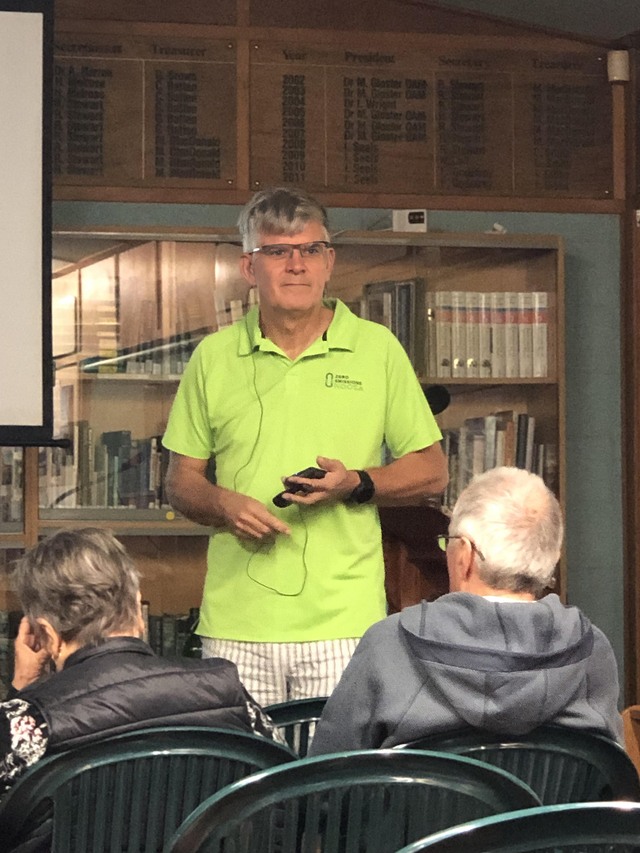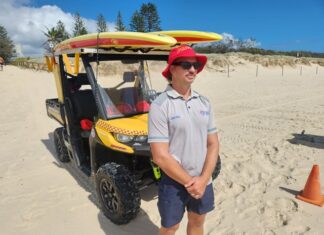
The Noosa community could save about $100 million a year if all of Noosa’s 27,000 households switched to sustainable energy, which is cost of living relief worth pursuing, Zero Emissions Noosa (ZEN) deputy chair Mark Purcell told guests at Noosa Parks Association Friday Environment Forum this month.
An electrical engineer Mark’s Noosa residence has been net carbon zero for the past two years after he replaced his hailstorm damaged car for an electric one, installed solar panels on his house which he uses to charge his car and replaced gas appliances with electric, saving him significantly on energy bills.
He’s now on a mission to help others do the same thing through ZEN’s Noosa Council-supported Rewiring Noosa project.
“Australia has a unique position, it can transform living and maintain its quality of life,” he said.
“Being in Queensland, the Sunshine State, we have an unfair advantage in terms of accessing natural resources and maintaining our lifestyle.”
Mark said ZEN’s economic analysis for Noosa calculated cost savings conservatively at about $3,500 a year for households that switch from fossil fuels to renewable energy which across the region’s 27,000 households adds up to about $100 million annually.
“It’s not complicated but dependent on every one of us,” he said. Another advantage of changing to solar is the creation of local jobs for tradies to do the work of installing solar panels.
Mark said converting households to renewables required an initial outlay with a general payback period of 3 to 5 years but there were opportunities for government grants to assist with the outlay.
About 50 per cent of houses in Noosa have solar power with the highest take up in the hinterland.
“A typical Australian house has a petrol or diesel car, gas heaters, gas stoves, grid energy fuelled by fossil fuels,” he said. “Queensland runs off a lot of coal and natural gas, has a lot of solar and a little wind.
During the day the power grid in Queensland uses about 50 per cent renewables and 50 per cent coal, at night it uses 100 per cent coal, while other states operate differently, with South Australia using a lot of wind power and Tasmania a lot of hydro, Mark said.
“The cheapest source of energy in the world is Australian roof top solar,” he said.
Compared to the general cost from Energex of about 42 cents per kilowatt hour, a solar system which has about a 25 year lifetime costs 3 cents per kilowatt hour – solar is the cheapest source of energy, the cheapest solar systems in the world are in Australia, he said.
In addition Energex charges about 10 cents per kilowatt hour to transport energy along transmission lines to household, rooftop solar needs no transportation.
When it comes to nuclear power Mark said discussions around it were fascinating as it would probably come in at 20 to 30 cents per kilowatt hour plus 10 cents for transmission, which is about what we’re paying Energex at the moment.
To switch to renewables Mark put in an 18 kilowatt solar system but said a typical household solar system required about 6 kilowatts, costing an average $1000 per kilowatt.
“If the sun doesn’t shine, you need a backup. You can run the system during day when the sun shines, with a battery charging during day and running the house at night on battery. It can half energy costs with solar. With a battery, you can reduce energy costs to zero. I’ve reduced it to below zero. They pay me, I export power to grid,” he said.
“I’ve calculated I’m saving about $15,000 per year. I’ve got a big house, a pool, air conditioning. I’m making money from my household and saving a bunch of stuff – it’s an exciting time.”
Mark has replaced his gas cooktops with more efficient electric induction cooktops, which use magnetic resonance, creating a magnetic field which means there is no wasted heat, but they do require the use of iron based pots to operate and there are health considerations with magnetic resonance being an issue for pacemakers.
Mark said both Noosaville and Cooroy libraries had home energy kits which contained electric induction heaters for loan so people can take them home and try them out.
When asked about difficulties charging his Tesla model 3 Mark said over summer he did a road trip from Noosa to Tasmania. He had ‘zero problems’ finding charging stations after typing in where to stop and charge and the 8000 kilometre trip cost about $300 in charging fees, he said.
At home he does most of charging off his solar panels, which doesn’t cost anything, and for people travelling on the Bruce Highway there are fast chargers at service stations, he said.
He said for people who have to charge their cars at home at night using fossil fuels, the electric machines are still emitting less carbon dioxide and are four times more energy efficient.
In the three years of owning an electric car, apart from replacing tyres and having wheel alignments his major service item has been the replacement of windscreen wipers. “There are a lot less moving parts. Servicing costs are virtually non-existent,” he said.
When it comes to replacing a car battery Mark said they do degrade over time but car batteries can have a second life by being turned into a house battery.
“A car battery has five to 10 times the capacity of a house battery,” he said.
“That’s going to solve a lot of issues – generate it locally, store it locally, transmission issues go away.”
Currently less than 10 per cent of Noosa houses have batteries, with the economics not justifying the costs.
A community battery is on the horizon after Noosa was selected for a federal government $500,000 community battery grant and a location has been identified for it to be installed. Mark said ZEN has estimated the community would need about 200 community batteries for Noosa households.
For more information on ZEN, its projects, its tool kits that provide information around renewables or community engagement sessions, visit zeroemissionsnoosa.com.au






